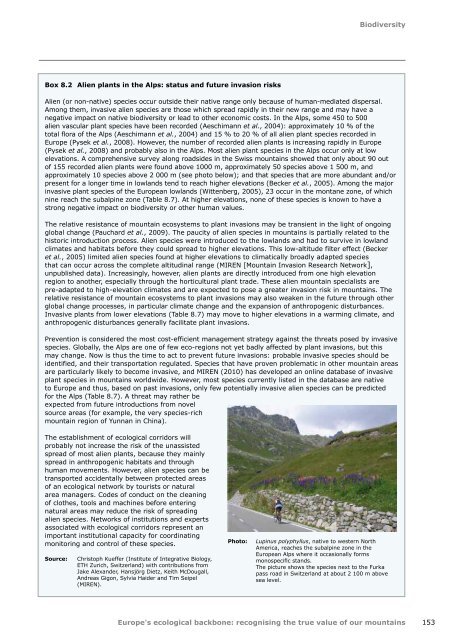Europes ecological backbone.pdf
Europes ecological backbone.pdf
Europes ecological backbone.pdf
You also want an ePaper? Increase the reach of your titles
YUMPU automatically turns print PDFs into web optimized ePapers that Google loves.
Biodiversity<br />
Box 8.2 Alien plants in the Alps: status and future invasion risks<br />
Alien (or non-native) species occur outside their native range only because of human-mediated dispersal.<br />
Among them, invasive alien species are those which spread rapidly in their new range and may have a<br />
negative impact on native biodiversity or lead to other economic costs. In the Alps, some 450 to 500<br />
alien vascular plant species have been recorded (Aeschimann et al., 2004): approximately 10 % of the<br />
total flora of the Alps (Aeschimann et al., 2004) and 15 % to 20 % of all alien plant species recorded in<br />
Europe (Pysek et al., 2008). However, the number of recorded alien plants is increasing rapidly in Europe<br />
(Pysek et al., 2008) and probably also in the Alps. Most alien plant species in the Alps occur only at low<br />
elevations. A comprehensive survey along roadsides in the Swiss mountains showed that only about 90 out<br />
of 155 recorded alien plants were found above 1000 m, approximately 50 species above 1 500 m, and<br />
approximately 10 species above 2 000 m (see photo below); and that species that are more abundant and/or<br />
present for a longer time in lowlands tend to reach higher elevations (Becker et al., 2005). Among the major<br />
invasive plant species of the European lowlands (Wittenberg, 2005), 23 occur in the montane zone, of which<br />
nine reach the subalpine zone (Table 8.7). At higher elevations, none of these species is known to have a<br />
strong negative impact on biodiversity or other human values.<br />
The relative resistance of mountain ecosystems to plant invasions may be transient in the light of ongoing<br />
global change (Pauchard et al., 2009). The paucity of alien species in mountains is partially related to the<br />
historic introduction process. Alien species were introduced to the lowlands and had to survive in lowland<br />
climates and habitats before they could spread to higher elevations. This low-altitude filter effect (Becker<br />
et al., 2005) limited alien species found at higher elevations to climatically broadly adapted species<br />
that can occur across the complete altitudinal range (MIREN [Mountain Invasion Research Network],<br />
unpublished data). Increasingly, however, alien plants are directly introduced from one high elevation<br />
region to another, especially through the horticultural plant trade. These alien mountain specialists are<br />
pre-adapted to high‐elevation climates and are expected to pose a greater invasion risk in mountains. The<br />
relative resistance of mountain ecosystems to plant invasions may also weaken in the future through other<br />
global change processes, in particular climate change and the expansion of anthropogenic disturbances.<br />
Invasive plants from lower elevations (Table 8.7) may move to higher elevations in a warming climate, and<br />
anthropogenic disturbances generally facilitate plant invasions.<br />
Prevention is considered the most cost-efficient management strategy against the threats posed by invasive<br />
species. Globally, the Alps are one of few eco-regions not yet badly affected by plant invasions, but this<br />
may change. Now is thus the time to act to prevent future invasions: probable invasive species should be<br />
identified, and their transportation regulated. Species that have proven problematic in other mountain areas<br />
are particularly likely to become invasive, and MIREN (2010) has developed an online database of invasive<br />
plant species in mountains worldwide. However, most species currently listed in the database are native<br />
to Europe and thus, based on past invasions, only few potentially invasive alien species can be predicted<br />
for the Alps (Table 8.7). A threat may rather be<br />
expected from future introductions from novel<br />
source areas (for example, the very species‐rich<br />
mountain region of Yunnan in China).<br />
The establishment of <strong>ecological</strong> corridors will<br />
probably not increase the risk of the unassisted<br />
spread of most alien plants, because they mainly<br />
spread in anthropogenic habitats and through<br />
human movements. However, alien species can be<br />
transported accidentally between protected areas<br />
of an <strong>ecological</strong> network by tourists or natural<br />
area managers. Codes of conduct on the cleaning<br />
of clothes, tools and machines before entering<br />
natural areas may reduce the risk of spreading<br />
alien species. Networks of institutions and experts<br />
associated with <strong>ecological</strong> corridors represent an<br />
important institutional capacity for coordinating<br />
monitoring and control of these species.<br />
Source:<br />
Christoph Kueffer (Institute of Integrative Biology,<br />
ETH Zurich, Switzerland) with contributions from<br />
Jake Alexander, Hansjörg Dietz, Keith McDougall,<br />
Andreas Gigon, Sylvia Haider and Tim Seipel<br />
(MIREN).<br />
Photo:<br />
Lupinus polyphyllus, native to western North<br />
America, reaches the subalpine zone in the<br />
European Alps where it occasionally forms<br />
monospecific stands.<br />
The picture shows the species next to the Furka<br />
pass road in Switzerland at about 2 100 m above<br />
sea level.<br />
Europe's <strong>ecological</strong> <strong>backbone</strong>: recognising the true value of our mountains<br />
153

















